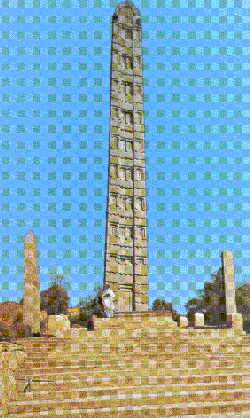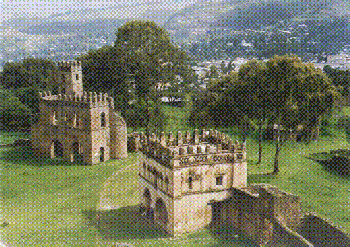
Article by MAUNFU 9

One of the most significant powers of the ancient world, the land now known as Ethiopia has gone by many names and has known a number of different cultures in different eras. Its preeminence as a civilizing culture cannot be denied.
The Empire of Axum
Axum's Origin
The Kingdom of Axum rose concurrent with the start of the Christian era to become a prominent commercial center of the ancient world. It had a history of literacy from its inception and produced literature not only in the native script called Ge'ez, but also in Greek which was then a language of commerce. Ge'ez was a Kushitic language attesting to the foundation of the kingdom by peoples from the kingdom of Kush and the black populations of Saudi Arabia. Indeed, by 200 A.D., Axum ( or Aksum) had conquered and absorbed the Kushitic kingdom of Meroe thereby gaining even greater preeminence. Soon, under the legendary King Ezana, the empire not only controlled much of the Horn of Africa, but territory in Asia as well, particularly across the Red Sea in Southwestern Arabia and what is now Yemen. The importance of this territory to the African state was its strategic commercial importance and location central to the trade routes between the Roman Empire, Africa and the great Asian powers of India and China.
Axum was now the central authority of a federated state made up of a number of subservient lands. By the third century A.D. ,The King now carried the title Negusa Nagast ( King of Kings ), a title which survived through subsequent Ethiopian rulers to the modern era. Several major cities flourished in the empire at this time including Axum, Haghero-Deragoueh, Degoum, Takonda and Henzat.
Axum's geographical location made it a nexus point between three religious schools; Judaism, Christianity and Islam. The Hebraic tradition in the region goes back to the very inception of the religion. The Hebrew patriarchs understood their African origins and maintained close cultural and spiritual ties with the African interior. By the second century A.D., however, Axum had become a christian empire under King Ezana, establishing its own unique tradition of the religion which would constantly be at odds with the Catholic Church. Like much of the surrounding area, Ethiopian christianity originates from the work of the Apostle James, who after a split with the proselytizing St. Paul, retreated south into Africa with what he held to be the true Christian tradition of Jesus before it was bastardized by political forces. The tradition is quite simillar to the theology of Ancient Nubia and Egypt in that it rejects the idea of Christ having the dual and distinct natures of God and Man which has made Him into a remote spiritual personage which no man may emulate. It contends that Christ was man and that his Godhood is inherent in his humanity, i.e.: that MAN IS GOD - a necessary result of the Creator's infinite capacity to love. As such, it makes all mankind capable of achieving what Christ did. This era of Ethiopian history is known to us thanks to a fine literary tradition as well as numerous architectural works. The succession of emperors is also known to us from the indigenous minted coins used in the realm in its extensive trade relations with Africa, Europe and Asia. As late as the eigth century A.D., Axum was considered one of the four powers of the world along with Visigothic Spain, Byzantium and Persia.
Axum's Decline
Changes in the geopolitical reality of its region of the world began to undermine the Kingdom. The Byzantine empire had been encroaching into Axumite territory since the sixth century, in a bid to control the Asiatic ports of Yemen. Although these attempts were largely unsuccessful, such was not the case with the expanding Persian Empire which seized control of the area and attacked Byzantine Egypt. Axum gradually began to be isolated commercially from trade through the Red sea corridor.
Another significant event was the spread of Islam throughout the region. The Islamic states had protected Axum from their Jihad in honor of the kingdom's historic act of protecting Prophet Mohammed's familly earlier in his life from the lords of Mecca. Legend has it that the prophet urged his followers to go to the court of Axum where they would find a king ( Armah or possibly his father Ella-Tsaham ) under whom there was no persecution. This truce however, only lasted a relatively short period. As the seventh century progressed, friction between Axum and the surrounding Islamic states led to a gradual weakening of the empire's influence. By the begining of the ninth century, Axum's preeminence had ended.
THE DYNASTY OF THE ZAGWE
With its Red Sea beachheads compromised, The Ethiopian Empire consolidated its territories in the African continent by taking control of the northern highlands and expanding southward deeper into Africa. The capital was moved progressively further south from Axum eventually to Amhara. This period of Ethiopian history is not as well documented as previous eras, but soon another great age would emerge under a succession of famous kings.
Towards the middle of the twelfth century, the Zagwe dynasty seized control of the kingdom under King Manara, firmly established Christianity as the state religion and began a rennaissance in culture. The dynasty claimed direct decendancy from Moses via his progeny with his Abbyssinian wife, who had been a princess. The hallmark of the 150 years or so of Zagwe rule are the 12 magnificent rock-hewn temples created by King Lalibela in the capital city Adefa, which was later renamed Lalibela. It is impossible to overstate the technical marvel these churches represent. Africa had previously had a history of this sort of construction. Legends from Nubia confirm this and the rock sculpture of ancient Kimet is well known. Axumite civilization itself, prior to the coming of the Zagwe, had erected innumerable such carved churches, but it is the size and majesty of the Lalibela churches which make them easily one of the wonders of the world.

Caucasian historians often point out the genius of sculptors such as Michelangelo, noting the extreme difficulties involved with carving in stone. The endeavor is quite unlike work in bronze and other metals because the technique - in those cases - is to carve out of clay, cast a mold around the carving and then pour molten metal into this mold to create the sculpture. The use of clay allows the correction of errors as the substance can be added or removed at will. Carving out of single masses of stone is a different matter. Mistakes which result in cuts going too deep are fatal. This means that margins for error are minute. In addition, the sheer scale of sculpture of Nubian, Egyptian and Ethiopian sculpture makes these not only remarkable artistic achievements, but wonders of architecture and engineering as well. Unique to African sensibilities, the Lalibela churches are carved down into the Earth and hollowed out to create the interiors.
Ethiopian Christianity was by now isolated from the European form of the religion. Its primary contacts were with the Egyptian Coptic Church with which it shared a common theology. Ethiopian civilization had created the first monasteries in the world and to this day, the Ethiopians profess to be the keepers not only of the true form of the religion, but also of the Hebrew faith as well. To this day, the keepers of the church of St. Mary of Zion claim to possess the fabled Ark of the Covenant snatched from King Solomon by his son Menelik. Ethiopian Christianity is therefore rich with its own traditions. Many original biblical works excised from the present Christian bible by Europe are used by the Ethiopians, including the Book of Enoch.
GONDER
The Zagwe dynasty eventually fell to a southern people, the Amhara, whose leaders claimed, not only decendancy from Solomon, but from the royalty of Axum as well. They would spread their rule over the empire, keeping their antagonistic Moslem neighbor states at bay and by the middle of the middle of the seventeenth century, would precide over another rennaissance led by the city of Gonder with renewed emphasis on literature and architecture. One of the most significant literary works in existence is the Kebra Nagast ( the Glory of Kings ), a treasure trove of African history, detailing the era of the Solomonic dynasty.
